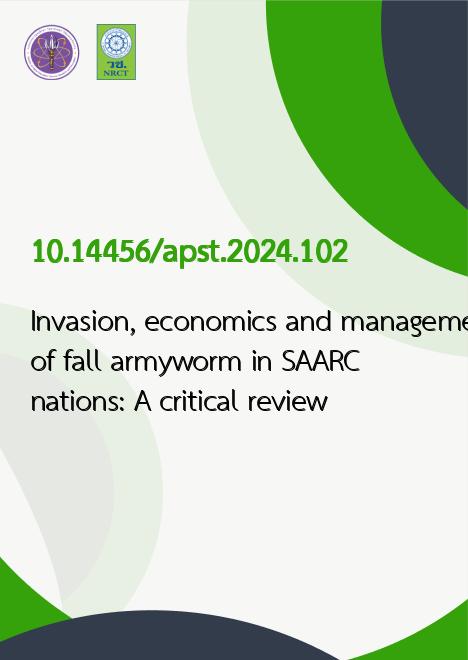
|
Invasion, economics and management of fall armyworm in SAARC nations: A critical review |
|---|---|
| รหัสดีโอไอ | |
| Creator | Shimul Das |
| Title | Invasion, economics and management of fall armyworm in SAARC nations: A critical review |
| Contributor | Toufiqur Rahman, Mahfuzur Rahman, Rubaiot Abdullah, Debobroto Das |
| Publisher | Asia-Pacific Journal of Science and Technology |
| Publication Year | 2567 |
| Journal Title | Asia-Pacific Journal of Science and Technology |
| Journal Vol. | 29 |
| Journal No. | 6 |
| Page no. | 17 (13 pages) |
| Keyword | Fall armyworm, SAARC, Natural enemies, Biopesticides, Economics |
| URL Website | https://so01.tci-thaijo.org/index.php/APST/ |
| Website title | https://so01.tci-thaijo.org/index.php/APST/article/view/269637 |
| ISSN | 2539-6293 |
| Abstract | Fall armyworm (FAW) is an invasive transboundary insect pest that feeds on more than eighty different plant species. It is especially devastating to grain crops like maize and sorghum. Ecological success of FAW relies on its versatility and capacity to adapt to a wide range of climatic situations. In warm and muggy climates, females can lay up to two thousand eggs, which will hatch into voracious larvae which consume large amounts of plant tissue. It is well-documented that this insect can travel great distances when aided by winds and weather. From the Americas through Africa, Asia, and beyond, this pest was spotted in India in May 2018, and has expanded to other South Asian Association for Regional Cooperation (SAARC) countries like Bangladesh, Nepal, Bhutan, Sri Lanka, Afghanistan, and Pakistan, and may go further. Temperature fluctuations in SAARC nations allow FAW to cause more damage to maize in the summer (Kharif) than in the winter (Rabi), while sugarcane, rice and sorghum are less susceptible to its infestation. Global trade, transboundary transit, and natural dispersal mechanisms like migration all contribute to the spread and invasion of the pest. A successful integrated pest management plan for FAW should include the strategic deployment of resistant cultivars, crop rotation, pheromone traps, natural enemies of predators and parasitoids, entomopathogens, and bio- and synthetic pesticides. Only educating farmers on the biology and ecology of this pest and training them on how to optimize integrated management approaches would ascertain sustainable FAW management in SAARC nations. |